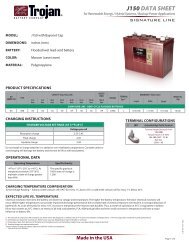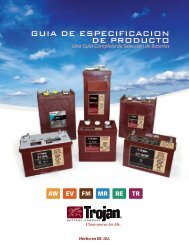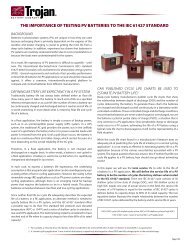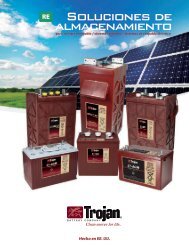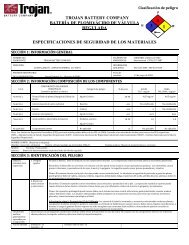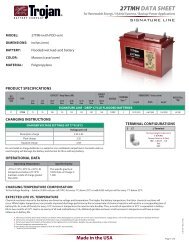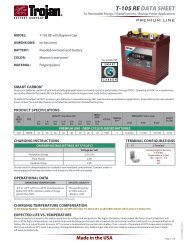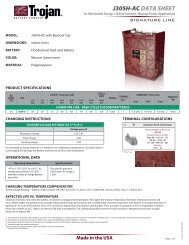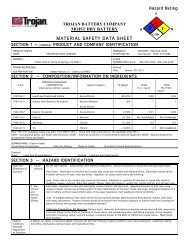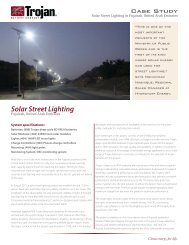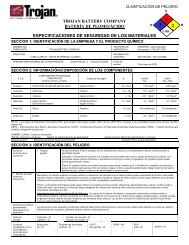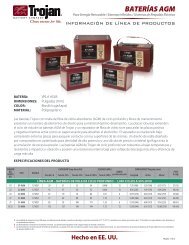Lead, Pasted Plates - Trojan Battery Company
Lead, Pasted Plates - Trojan Battery Company
Lead, Pasted Plates - Trojan Battery Company
- No tags were found...
You also want an ePaper? Increase the reach of your titles
YUMPU automatically turns print PDFs into web optimized ePapers that Google loves.
Chemical(s)Listed asCarcinogen orpotentialCarcinogenProposition 65 - YESNationalToxicologyProgram - YESI.A.R.C.Monographs - YESO.S.H.A. - NOEPACAG - YESN.I.O.S.H. - YESSECTION 4 - FIRST AID MEASURESEmergency and First Contact with <strong>Lead</strong>/<strong>Pasted</strong> <strong>Plates</strong>Aid Procedures1. Inhalation Move to ventilated area. Obtain medical attention if experiencing effects of overexposure.2. Eyes Flush the eyes with copious quantities of cool running water for 15 minutes. Obtain immediate medical attention.3. Skin Wash area thoroughly with soap and water.4. Ingestion Do not induce vomiting. If conscious drink large amounts of water/milk. Obtain medical attention. Never give anything bymouth to an unconscious person.5. <strong>Lead</strong> Exposure May cause lassitude, constipation, anemia, nausea, vomiting, paralysis, and central nervous system depression. Greatestexposure comes from dust in the air and on hands when packing/unpacking, and during lead acid battery manufacturing.SECTION 5 – FIRE-FIGHTING MEASURESFlash Point – NotApplicableSpecial Fire FightingProceduresUnusual Fire andExplosion HazardsFlammable Limits in Air LowerUpper% by Volume N/AN/AExtinguishing Media – Dry Chemical or CO 2 Auto-Ignition - Not ApplicableTemperatureDo not use water on fires where molten metal is present. Use NIOSH/MSHA approved SCBA and full body protective equipmentoperated in positive pressure mode.Molten metals produce fumes and/or vapor that may be toxic or respiratory irritants. Product can react vigorously with strongoxidizing agents.SECTION 6 – ACCIDENTAL RELEASE MEASURESProcedures for Cleanup: Avoid contact with any spilled material. Contain spill, isolate hazard area, and deny entry. Limit site access to emergency responders.Material should be vacuumed with HEPA filter or wet swept and stored in dry containers for later disposal. Do not use compressed air or dry sweeping as ameans of cleaning.Personal Precautions: Wear protective clothing and appropriate NIOSH/MSHA approved respirator. ANSI approved safety glasses with side shieldsrecommended.Environmental Precautions: <strong>Lead</strong> and its compounds are a severe threat to the environment. Contamination of water, soil and air should be prevented.SECTION 7 – HANDLING AND STORAGEPrecautions to be Takenin Handling and StorageOther PrecautionsStore away from reactive materials, open flames and sources of ignition as defined in Section 10 – Stability and Reactivity.GOOD PERSONAL HYGIENE AND WORK PRACTICES ARE MANDATORY. Refrain from eating, drinking or smoking in work areas.Thoroughly wash hands, face, neck and arms before eating, drinking and smoking. Work clothes and equipment should remain in designatedlead contaminated areas, and never taken home or laundered with personal clothing. Wash soiled clothing, work clothes, and equipmentbefore reuse.SECTION 8 – EXPOSURE CONTROLS AND PERSONAL PROTECTIONRespiratoryProtectionVentilationProtectiveGlovesOther ProtectiveClothing orEquipmentNIOSH approved respirator is required when the PEL is exceeded or employee experiences respiratory irritation. When exposure levels are unknown orwhen fire-fighting, wear a self-contained breathing apparatus with a full face-piece operated in positive pressure mode.Use adequate general or local exhaust ventilation to keep airborne concentration below the PEL.Rubber Gloves Eye Protection ANSI approved safety glasses with side shields recommended.Aprons, boots and protective clothing appropriate for an industrial environment. Ventilation, as described in the Industrial Ventilation Manual producedby the American Conference of Governmental Industrial Hygienists, shall be provided in areas where exposures are above the PEL or TLV specified byOSHA or other local, state and federal regulations. Safety shower and eyewash.
SECTION 9 – PHYSICAL AND CHEMICAL PROPERTIESBoiling Point: Not Applicable Vapor Not ApplicableSpecific 7.4 g/mlMelting Point: 550°FPressureGravityPercent Volatile Not ApplicableVapor Not ApplicableEvaporation Not applicableBy VolumeDensityRateSolubility 33 mg/lReactivity in Water NoneIn waterAppearance and Odor: <strong>Lead</strong>: Gray metallic, solid Product manufactured by pasting lead oxide over lead frame (grid).<strong>Lead</strong> Oxide: Orange or gray pasteNo apparent odorSECTION 10 – STABILITY AND REACTIVITYStability: Stable Conditions to Avoid: Intense Heat; avoid high concentrations of corrosives/acids.IncompatibilityStrong oxidizers and this product may liberate hydrogen gas.(Materials to Avoid)HazardousMolten metals produce fumes and/or vapors that may be toxic or respiratory irritants.Decomposition ProductsHazardousHazardous Polymerization has not been reported.PolymerizationSECTION 11 - TOXICOLOGICAL INFORMATIONGENERAL: The primary routes of exposure are ingestion or inhalation of dust.ACUTE:INHALATION/INGESTION: Exposure to lead and its compounds may cause headache, nausea, vomiting, abdominal spasms, fatigue, sleep disturbances, weight loss,anemia, and pain in the legs, arms and joints. Kidney damage, as well as anemia, can occur from acute exposure.CHRONIC:INHALATION/INGESTION: Prolonged exposure to lead and its compounds may produce many of the symptoms of short-term exposure and may also cause central nervoussystem damage, gastrointestinal disturbances, anemia, and wrist drop. Symptoms of central nervous system damage include fatigue, headaches, tremors, hypertension,hallucination, convulsions and delirium. Kidney dysfunction and possible injury has also been associated with chronic lead poisoning. Chronic overexposure to lead hasbeen implicated as a causative agent for the impairment of male and female reproductive capacity, but there is at present, no substantiation of the implication. Pregnantwomen should be protected from excessive exposure. <strong>Lead</strong> can cross the placental barrier and unborn children may suffer neurological damage or developmentalproblems due to excessive lead exposure in pregnant women.SECTION 12 - ECOLOGICAL INFORMATIONIn most surface water and groundwater, lead forms compounds with anions such as hydroxides, carbonates, sulfates, and phosphates, and precipitates out of the watercolumn. <strong>Lead</strong> may occur as sorbed ions or surface coatings on sediment mineral particles or may be carried in colloidal particles in surface water. Most lead is stronglyretained in soil, resulting in little mobility. <strong>Lead</strong> may be immobilized by ion exchange with hydrous oxides or clays or by chelation with humic or fulvic acids in the soil. <strong>Lead</strong>(dissolved phase) is bioaccumulated by plants and animals, both aquatic and terrestrial.SECTION 13 - DISPOSAL CONSIDERATIONSDISPOSE IN ACCORDANCE WITH LOCAL, STATE AND FEDERAL REGULATIONS FOR LEAD AND LEAD COMPOUNDS.SECTION 14 - TRANSPORT INFORMATIONU.S. DOT PROPER SHIPPING NAME: UN3077, (RQ) Environmentally Hazardous Substances, solid, n.o.s.U.S. DOT HAZARD CLASS: 9U.S. DOT ID NUMBER: UN3077U.S. DOT PACKING GROUP: IIIU.S. DOT LABEL: Class 9SECTION 15 - REGULATORY INFORMATIONU.S. HAZARDOUS UNDER HAZARD COMMUNICATION STANDARD:LEAD – YESANTIMONY – YESARSENIC – YESLEAD SULFATE - YESINGREDIENTS LISTED ON TSCA INVENTORY: YES
CERCLA SECTION 304 HAZARDOUS SUBSTANCES: LEAD – YES RQ: REPORTING NOT REQUIRED WHEN DIAMETEROF THE PIECES OF SOLID METAL RELEASEDIS EQUAL TO OR EXCEEDS 100 µm(micrometer).ANTIMONY – YESRQ: 5000 POUNDSARSENIC – YESRQ: 1 POUNDLEAD SULFATE –YESRQ: 10 POUNDSEPCRA SECTION 313 TOXIC RELEASE INVENTORY: LEAD – CAS NO: 7439-92-1ANTIMONY – CAS NO: 7440-36-0ARSENIC – CAS NO: 7440-38-2LEAD SULFATE – CAS NO: 7446-14-2SECTION 16 - OTHER INFORMATIONTHE INFORMATION ABOVE IS BELIEVED TO BE ACCURATE AND REPRESENTS THE BEST INFORMATION CURRENTLY AVAILABLE TO US. HOWEVER,TROJAN BATTERY COMPANY MAKES NO WARRANTY OF MERCHANTABILITY OR ANY OTHER WARRANTY, EXPRESSED OR IMPLIED, WITH RESPECT TOSUCH INFORMATION, AND WE ASSUME NO LIABILITY RESULTING FROM ITS USE. USERS SHOULD MAKE THEIR OWN INVESTIGATIONS TODETERMINE THE SUITABILITY OF THE INFORMATION FOR THEIR PARTICULAR PURPOSES. ALTHOUGH REASONABLE PRECAUTIONS HAVE BEENTAKEN IN THEPREPARATION OF THE DATA CONTAINED HEREIN, IT IS OFFERED SOLELY FOR YOUR INFORMATION, CONSIDERATION ANDINVESTIGATION. THIS MATERIAL SAFETY DATA SHEET PROVIDES GUIDELINES FOR THE SAFE HANDLING AND USE OF THIS PRODUCT; IT DOESNOT AND CANNOT ADVISE ON ALL POSSIBLE SITUATIONS, THEREFORE, YOUR SPECIFIC USE OF THIS PRODUCT SHOULD BE EVALUATED TO DETERMINEIF ADDITIONAL PRECAUTIONS ARE REQUIRED.Form MSDS Rev. January 09, 2012



